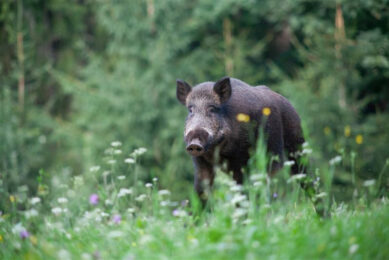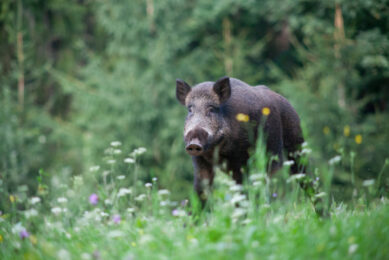Lifetime sow performance – a key indicator of profit
Pigs per sow per year and numbers weaned have always been the main performance criteria adopted by pig producers to judge the success of their business.
Both are useful indicators, indeed JSR have a commercial target of 25 pigs per sow per year, but it is important that producers keep an open mind on how they can measure unit efficiency and productivity.
©
Too often in business we focus on the wrong indicators, thereby missing the effect on the most important one – profit. ‘Pigs per sow per year’ as mentioned is one indicator, among many others, that contribute to profitability. But too much focus on PSY means other indicators such as lifetime performance of the sow and feed efficiency can become neglected. Today the pig producers who have, and continue to run successful, sustainable businesses are those who understand the key indicators of profit and focus on them relentlessly.
©
Andrew Knowles of BPEX targeted the ‘2 tonne sow’ to stay competitive in Europe, however this raises the inevitable question:©how much further can the modern sow be expected to increase born alive figures without compromising its well-being and the viability of piglets?©As with any business, it is a valuable exercise to regularly take a step back and view the bigger picture.©In this case, it is worthwhile to focus on enhancing overall unit profitability and, rather than pigs per sow per year, concentrate on optimising the lifetime performance of the sow.
©
©
The JSR ‘5.5 tonne lifetime sow’
JSR Genetics’ performance data indicates that in its lifetime a JSR Genepacker 90 sow averages 80 piglets and 5.5 tonnes of meat.
©
Sow performance*
©
Parity | Born alive |
1 | 11.9 |
2 | 13.3 |
3 | 13.6 |
4 | 14.0 |
5 | 13.4 |
6 | 13.3 |
©
*Figures based on trials at Harper Adams University College with predictions for parities 5/6
©
©
JSR Genepacker 90 ‘5.5 tonne lifetime sow’ performance
©
© Lifetime born alive | © 80 pigs |
Weaned (12% pre-weaning mortality) | © 70 pigs |
© Sold (5% post-weaning mortality) | © 67pigs |
© Kilos (at 109kgs lwt) | © 7245 kgs |
© Kilos (as 76% KO %) | © 5500kg meat |
The performance is a result of sound genetic improvement focusing on robustness and prolificacy. However the true measure of unit efficiency is cost of production.©With feed at 55-60% of input costs, determining the Meat per tonne of Feed (MTF) or Feed Conversion Ratio (FCR) plays a vital part in determining production costs and improving efficiency.©MTF is the simplest and most useful measurement and, using feed invoices and slaughter house returns, it can be calculated by subtracting the total amount of feed used from the total tonnage of meat produced – JSR work towards a commercial target of 325 kgs MTF.
©
In a commercial herd, using JSR Geneconverter 700 genetics on Genepacker 90 sows, 1754 tonnes of feed was used for 6799 slaughter pigs with an average of 85.0kg deadweight. The 578,000 kilos of pigmeat gave a highly respectable MTF of 329kg.©These are important calculations when considering the profitability of pig production – but many producers are still unable to produce these figures for their own units.
©
Output per facility – avoid a £55,000 shortfall!
A readiness to quote ‘pigs per sow per year’, focusing on prolificacy as the performance criteria, should never sidetrack producers from attending to all aspects of unit efficiency. For example, ensuring units are used to their full capacity can avoid substantial income shortfalls, as demonstrated below:
©
In a 12 sow unit, which is more efficient?
·©©©©©©© Unit A: 10 sows farrowing 12 pigs per sow = 120 pigs,
©
·©©©©©©© Unit B: 12 sows farrowing 10.8 pigs per sow = 129.6 pigs©
©
Unit B weans 9.6 more pigs. Over 52 weeks this equates to 499.2 pigs x £110 per pig (average weight of 80kg) = £55,000.©
©
So Unit A, even though farrowing more Pigs per Sow per Year, has a £55,000* annual sales shortfall by not using the unit to fullcapacity (*figure rounded up to nearest £1k)
©
©
Attention to detail
One way to ‘view the bigger picture’ of a unit and to help it achieve its full potential is get an outside opinion using an independent production consultant and software written specifically for the pig industry. Checkmate®, for example, a monitoring programme designed by industry consultant Paul Wright, can estimate the profit potential of any given unit and formulate a detailed regime to help achieve it. Using day to day data (from building and pen sizes to service intervals and stocking rates) it can provide realistic production targets and pinpoint elements that are causing a shortfall. By utilising such a programme, producers can then set realistic targets, work to reduce overheads and increase profitability.
©
Expert advice for unit profitability
The technical support of breeders is a readily available facility that producers should also exploit. At JSR sustained investment in R&D, and owning established commercial herds, gives us an ability to advise on production, from all aspects of fertility and farrowing routines to stock handling. Nutrition support, for formulation advice on specific diets, and expert veterinary guidance are also key in ensuring that both sow and progeny fulfil their genetic potential.©
©
(By Giles Christie, UK Sales Director, JSR Genetics)
©
Join 18,000+ subscribers
Subscribe to our newsletter to stay updated about all the need-to-know content in the pigsector, three times a week.











